The BEST All-Purpose Stir Fry Sauce Recipe (Easy!)
This super easy 5-minute Chinese Stir Fry Sauce Recipe perfectly complements any stir-fried meat and veggies. A delicious, budget-friendly, homemade sauce made with simple ingredients and steps. It’s so good you’ll never buy store-bought or takeout versions again!
Table of Contents
Why You’ll Love This Recipe!
Allow me to introduce you to the BEST, easy Stir Fry Sauce Recipe! I love this sauce because it tastes as good (or better!) than a Chinese restaurant, but is super simple. Just add the ingredients to a mason jar, shake, or whisk, and serve! Homemade sauces are always a hit around here because they’re so easy to customize!
This sauce pairs perfectly with all stir fries- Any beef, shrimp, tofu, pork, chicken breast, chicken thighs, or vegetable stir-fry dish. Serve with white rice, or use my cauliflower rice hack for a low-carb option.
My favorite thing about making stir-fries is that I use whatever fresh produce and protein I have on hand. I typically make it once a week in order to clean out my produce drawer and use up meat I’ve defrosted. It takes less than 30 minutes to make a complete meal of vegetables and protein and this delicious, addicting sauce!
Recipe Highlights
- Budget-Friendly: This recipe tastes better than takeout and store-bought sauce and is much less expensive!
- Easy Recipe: Making your own Chinese stir fry sauce recipe is easy and healthier than alternatives, but it still tastes like a high-quality meal! Perfect for busy weeknights.
- Flavorful: Savory, sweet, and tangy flavors like soy sauce, sesame oil, rice vinegar, ginger, and garlic are all whisked together, bursting with flavor—all the things you love about Asian-inspired recipes in one lovely sauce.
- Easy Swaps & Variations: Adjust this recipe to be vegan or gluten-free, spicy or mild, soy-free, and more.
Watch The Recipe Video
Note: You can also watch this recipe video on YouTube.
Ingredient Notes
Just 8 simple ingredients (mostly pantry staples!) and 1 step. It’s that easy! It’s a for-everyone kind of sauce, and in my house, that’s the BEST.
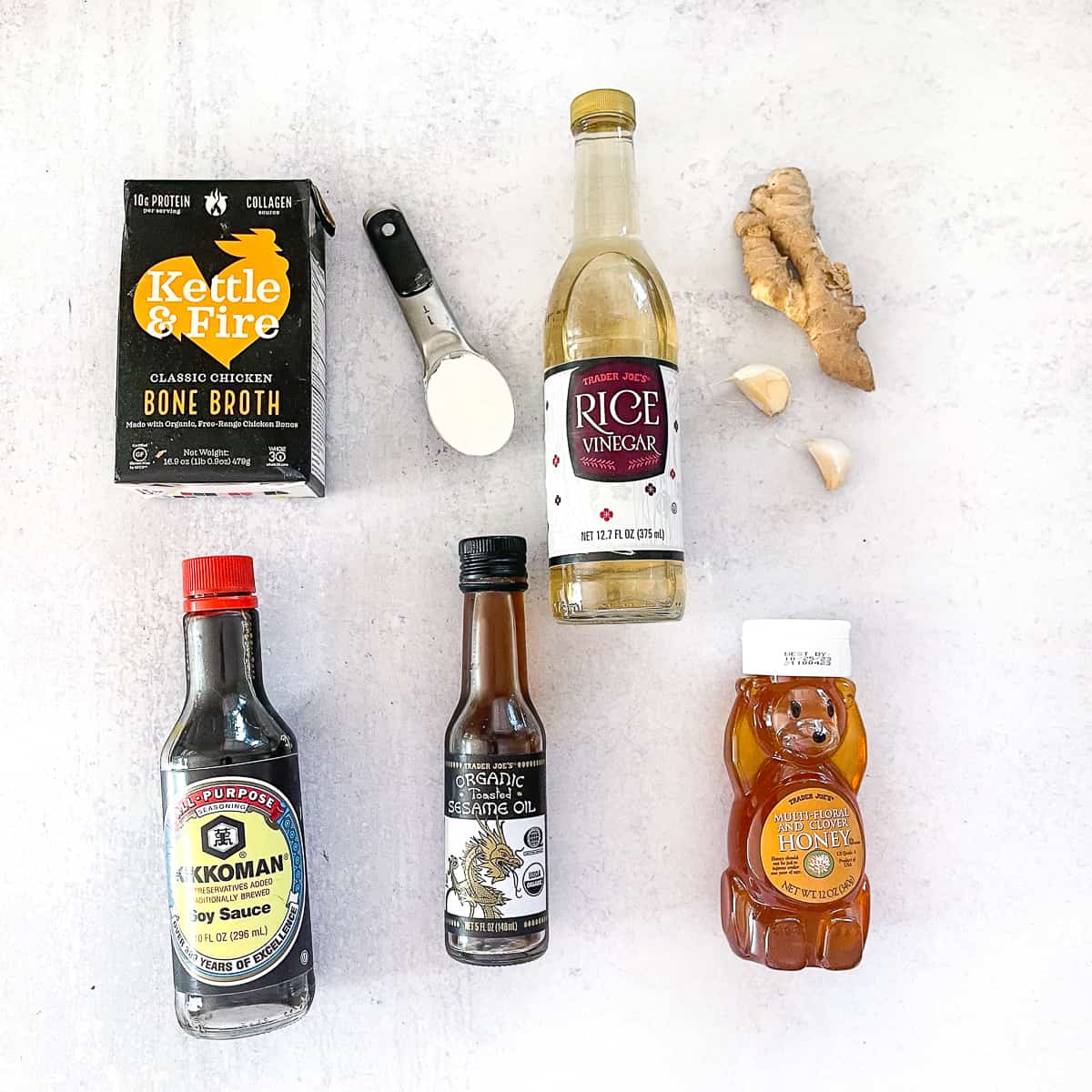
- Soy Sauce: Use low-sodium soy sauce because regular soy sauce is very salty. If you’re looking for a gluten-free soy sauce alternative, try Tamari (you seriously can’t tell the difference!). If you’re soy-free, use coconut aminos.
- Chicken Stock (or Chicken Broth): I use Kettle + Fire organic chicken bone broth (my favorite! Use code TASTESLOVELY for 20% off!). You can use chicken, beef, or veggie broth/stock. You can also use water if that’s all you have on hand. If you’re vegan, use vegetable broth.
- Cornstarch: In place of corn starch, you can use all-purpose flour, arrowroot starch, or tapioca flour (which is gluten-free!).
- Honey: Instead of brown sugar, I use honey. You can also use pure maple syrup, coconut sugar, or agave nectar if you want a vegan alternative. You can also use brown sugar if you prefer, but I like using natural sweeteners. It’s really up to you!
- Sesame Oil: This adds richness and depth that is so delicious.
- Rice Vinegar: This is where the sweet, tangy flavor comes from, and I personally love it. It’s a very mild vinegar, so it won’t overwhelm the sauce. You can also use white vinegar in a pinch.
- Fresh Ginger & Garlic: I like to use fresh ginger and mince fresh garlic cloves. It adds such a strong, delicious flavor. In a pinch, you can also use powdered ginger and garlic powder.
Check out the recipe card below for the complete list of ingredients and amounts.
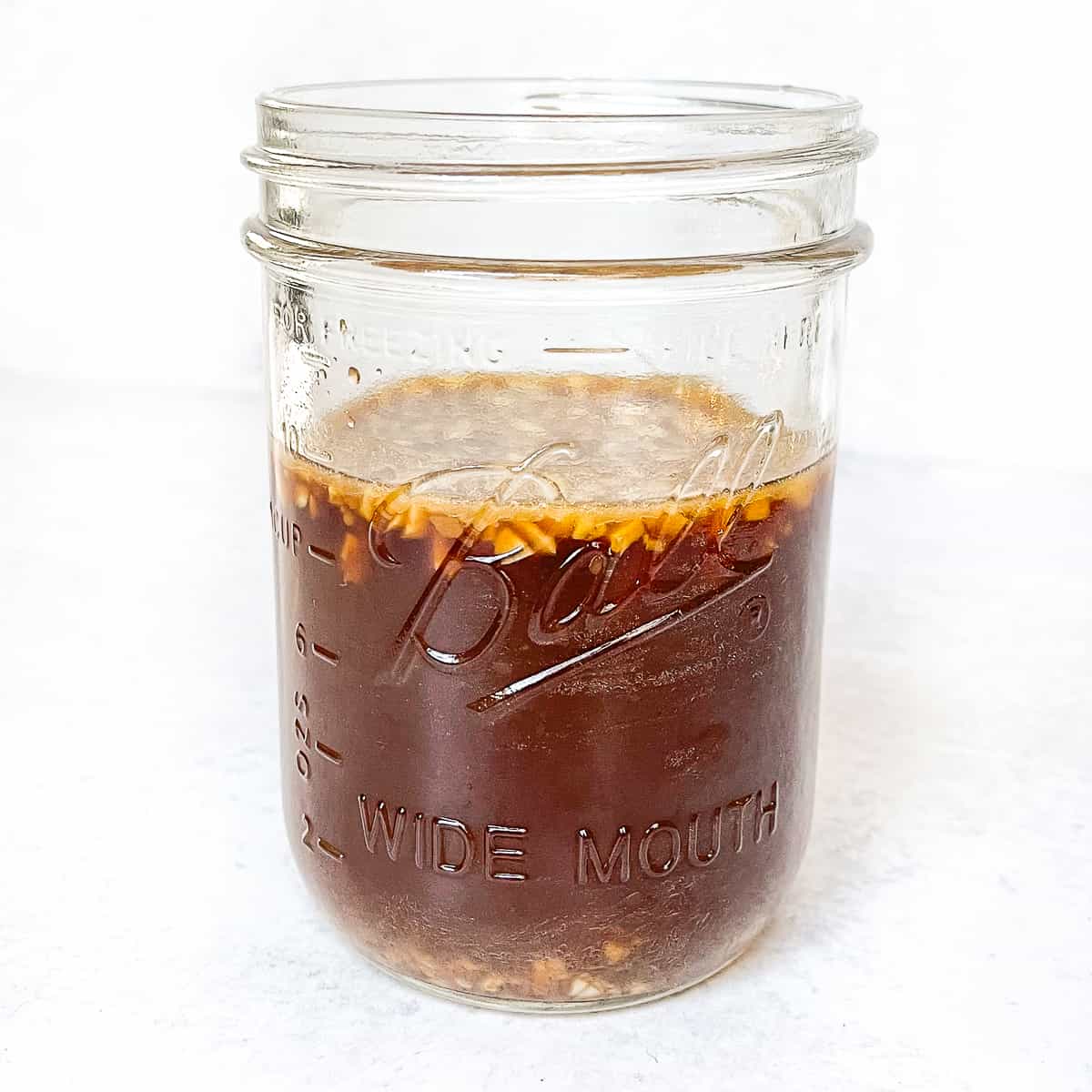
How to Make Stir Fry Sauce in 5 Minutes!
Step 1: Combine all the ingredients in a small bowl or mason jar, and whisk or shake until combined.
Step 2: Store for later use or add to your stir-fried protein and veggies (instructions below!).
Expert Tips & Recipe Variations
- When you add this sauce to your stir-fried veggies and protein, add the sauce last. Cook the sauce for 3 minutes over medium-high heat to allow the thickening agent to thicken.
- If you need a larger yield, click on the printable recipe in the recipe card below and adjust the number of servings. Changing the number of servings will adjust the ingredient amounts.
- Vegan: If you are vegan, use vegetable broth and agave nectar or pure maple syrup.
- Spice it Up: If you prefer a spicier sauce, add red pepper flakes (to taste). As written, this sauce is very mild.
- Keto/Low-Carb: If you are low-carb, use tapioca flour or arrowroot instead of cornstarch and monk fruit sweetener. Or click here for my Keto Stir-Fry Sauce recipe!
- Gluten-Free: While it seems like soy sauce is gluten-free, it’s not. If you’re gluten-free, use Tamari instead of soy sauce.
- Low-Sodium: I always use low-sodium soy sauce because the saltiness of regular soy sauce is overpowering. If you’re the same or need less salt for dietary reasons, use a low-sodium soy sauce or swap for coconut aminos.
How to Make a Simple Stir Fry Dinner!
Use this to make an easy beef stir fry or chicken stir fry (or vegetable stir fry with no meat) that serves 4, or check out my other homemade stir fry recipes for a fun variety of options. You can use whatever meat and veggies you have on hand. So clean out your produce drawer and enjoy!
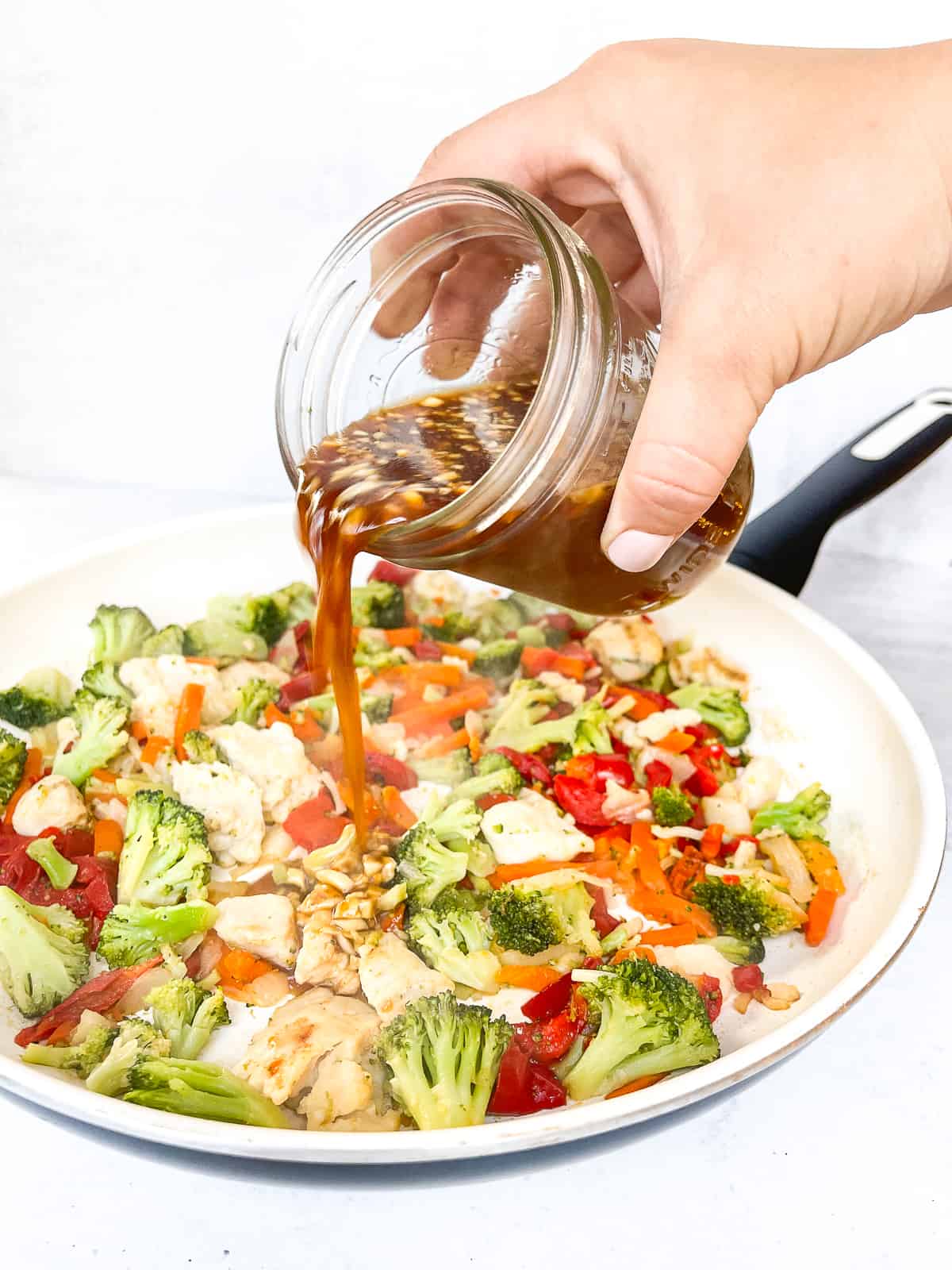
- Heat a large skillet over medium-high heat. Add in 2 tablespoons oil, then 1 pound of protein of your choice, cubed.
- Cook for 5-7 minutes, stirring occasionally, until the protein is cooked through. Transfer the protein to a plate.
- Add another 2 tablespoons of oil and 4 cups of chopped vegetables of your choice in the same skillet. (broccoli, green beans, bell peppers, asparagus, snow peas, bean sprouts, onion, mushrooms, carrots, snap peas, bok choy, zucchini, etc.). Cook for 5-7 minutes until the veggies are crisp-tender.
- Add the protein back to the pan, and pour over all 1-1/4 cups of the sauce. Allow coming to a bubble, which will activate the thickener.
- Remove from the heat and serve with warm cooked rice, cauliflower rice, or noodles.
Serving Tips
- This recipe yields 1-1/4 cups of sauce. This is the perfect amount for an easy beef or chicken stir fry that serves 4 for dinner or a great meal prep option.
- Smother your stir-fried meats and veggies with this sauce and serve warm over white or brown rice or cauliflower rice for a low-carb option. You can even serve it with your favorite Asian noodles. Customize it to your liking!
Storage Tips
- Leftovers: Store leftovers in an airtight container or mason jar with a lid in the refrigerator for up to 1 week, though you will probably eat them sooner!
- Freezing: If you have leftovers, you can freeze them! Freeze in any freezer-safe container for up to 6 months. Thaw overnight in the refrigerator, then reheat it over the stovetop to use for any Asian-inspired recipe.
Recipe FAQs
Yes! You can use my swaps above to make this recipe even healthier and lifestyle-friendly. It’s super versatile and tastes amazing in all the different ways you make it. Depending on your needs, if I’ve missed something here, please ask me in the comments, and I’d be happy to help you figure out swaps that work for your diet and lifestyle.
This recipe yields 1-1/4 cups of sauce, which is the perfect serving size for a stir fry recipe that serves 4 people. If you want more sauce, the printable recipe card below easily adjusts by increasing the number of servings you need.
You can use cornstarch, Tapioca Flour, or Arrowroot powder. If your sauce is too thin, add an additional 1 tsp at a time and stir for one minute. Continue to add until desired thickness is reached.
If you use vegetable broth, maple syrup, or agave instead of honey, yes! If you are a vegetarian but not vegan, you can use honey.
If you are soy-free, swap the soy sauce for liquid aminos or coconut aminos. You will achieve the same great flavor, without any soy.
Yes! Use low-sodium soy sauce, and low-sodium or “no salt added” broth or stock.
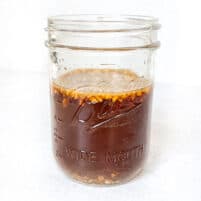
The BEST All-Purpose Stir Fry Sauce Recipe (Easy!)
Ingredients
- 1/2 cup low sodium soy sauce*, *Use Low-Sodium soy sauce as the saltiness of regular may be overpowering.
- 1/2 cup Kettle + Fire chicken stock bone broth
- 2 tablespoons fresh chopped ginger
- 2 cloves garlic, grated or finely minced
- 1 tablespoon corn starch
- 1 tablespoon honey
- 1 teaspoon sesame seed oil
- 1 teaspoon rice vinegar
Instructions
Stir Fry Sauce
- Combine all ingredients in a bowl or mason jar, and whisk or shake until combined.
- Makes 1-1/4 cups. You can use immediately, or keep refrigerated in an airtight container for 1 week.
How To Make A Stir Fry
- Heat a large skillet over medium-high heat. Add in 2 tablespoons oil, then 1 pound of protein of your choice, cubed.
- Cook for 5-7 minutes, stirring occasionally until the protein is cooked through. Transfer the protein to a plate.
- In the same skillet, add another 2 tablespoons of oil and 4 cups of chopped vegetables of your choice. (broccoli, green beans, bell pepper, asparagus, onion, mushrooms, zucchini, etc). Cook for 5-7 minutes until the veggies are crisp-tender.
- Add back in the protein, and pour over all 1-1/4 cups of the sauce. Allow coming to a bubble, which will activate the thickener.
- Remove from the heat and serve with warm cooked rice, cauliflower rice, or noodles.
Notes
Expert Tips/Recipe Variations
-
- USE LOW SODIUM SOY SAUCE! Using regular soy sauce can be too salty for some people.
- When you add this sauce to your stir-fried veggies and protein, add the sauce last. Cook the sauce for 3 minutes over medium-high heat to allow the thickening agent to thicken.
-
- If you need a larger yield, click on the printable recipe in the recipe card below and adjust the number of servings. Changing the number of servings will adjust the ingredient amounts.
-
- Vegan: If you are vegan, use vegetable broth and agave nectar or pure maple syrup.
-
- Spice it Up: If you prefer a spicier sauce, add red pepper flakes (to taste). As written, this sauce is very mild.
-
- Keto/Low-Carb: If you are low-carb, use tapioca flour or arrowroot instead of cornstarch and monk fruit sweetener. Or click here for my Keto Stir-Fry Sauce recipe!
-
- Gluten-Free: While it seems like soy sauce is gluten-free, it’s not. If you’re gluten-free, use Tamari instead of soy sauce.
- Low-Sodium: I always use low-sodium soy sauce because the saltiness of regular soy sauce is overpowering. If you’re the same or need less salt for dietary reasons, use a low-sodium soy sauce or swap for coconut aminos.
Substitutions
- Soy Sauce: If you are soy-free, you can substitute liquid aminos or coconut aminos in the same quantities. If you are looking for a gluten-free option, try Tamari.
- Chicken Stock: You can use chicken, beef, or veggie broth/stock. You can also use water if that’s all you have on hand.
- Fresh Ginger: In place of fresh ginger, use 2 teaspoons of powdered ginger.
- Cornstarch: In place of cornstarch, you can use all-purpose flour or tapioca flour (which is gluten-free!). Same quantity for all substitutions.
- Honey: In place of honey you can use maple syrup, agave nectar, white sugar, brown sugar, or coconut sugar. Same quantity for all substitutions.
- Rice Vinegar: In place of rice vinegar you can use white vinegar.
Serving Tips
-
- This recipe yields 1-1/4 cups of sauce. This is the perfect amount for an easy beef or chicken stir fry that serves 4 for dinner or a great meal prep option.
-
- Smother your stir-fried meats and veggies with this sauce and serve warm over white or brown rice or cauliflower rice for a low-carb option. You can even serve it with your favorite Asian noodles. Customize it to your liking!
Storage Tips
-
- Leftovers: Store leftovers in an airtight container or mason jar with a lid in the refrigerator for up to 1 week, though you will probably eat them sooner!
-
- Freezing: If you have leftovers, you can freeze them! Freeze in any freezer-safe container for up to 6 months. Thaw overnight in the refrigerator, then reheat it over the stovetop to use for any Asian-inspired recipe.

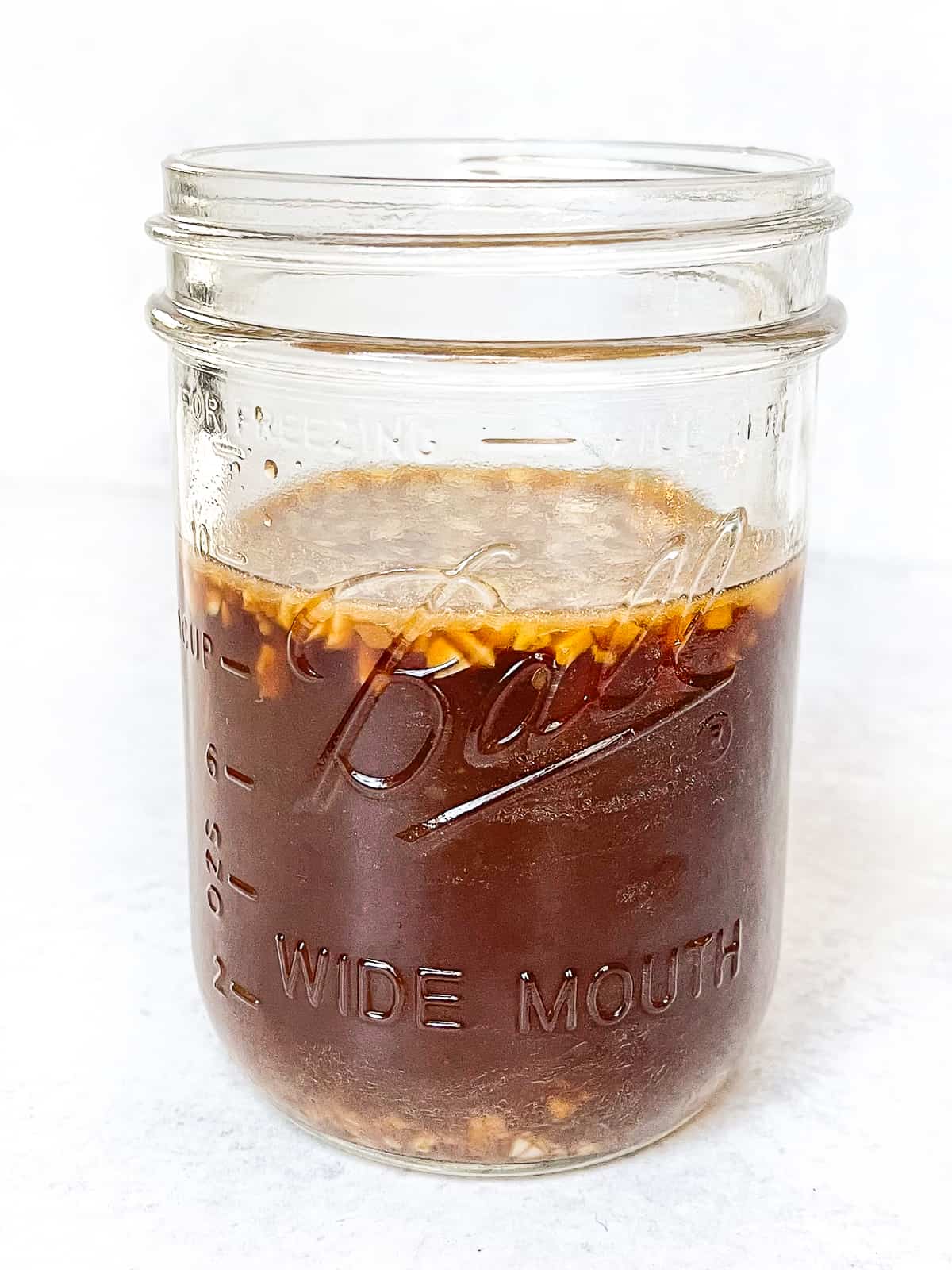
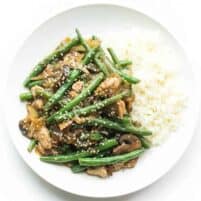

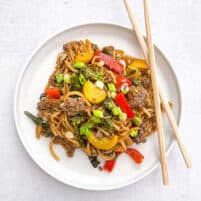
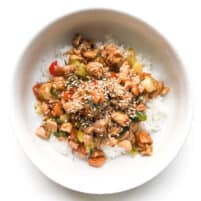
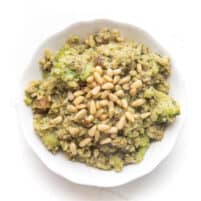

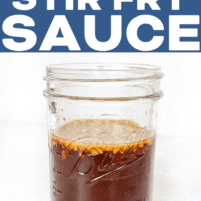
615 Comments on “The BEST All-Purpose Stir Fry Sauce Recipe (Easy!)”
The most flavourful & esy Stir fry sauce ive ever made, huge hit with family.
Thankyou
Substituting soy sauce for coconut aminos is the key for this sauce! So delicious, thank you!
Horrible and a huge waste of my time. No amounts given of sauce ingredients included. ie, number of teaspoons, tablespoons etc for each ingredient in the sauce. Worthless.
Great recipe but I left out the soy sauce and just used 1 cup chicken stock.
Good recipe but I only had normal soy and agree it’s too salty so make sure to use low sodium soy. I also found it needed a tad more honey but I guess it’s just personal taste. Thanks for the recipe.
the best.!!!!!!!!!!
Thank you!
the best!!!!!
Thank you!
Tasted like soy sauce and not much else. Would definitely increase the honey if I were to make it again, but I’ll be looking for a different recipe.
Sorry to hear this, Charlene. I haven’t had that issue, but bummed that you did!
I am looking forward to trying this recipe! About the sesame oil: do you mean the very strongly flavored, dark colored, toasted sesame oil or the light taste and colored sesame oil? I know my dark sesame oil has a super low smoking point, so I want to make sure I get it right! =) Thank you!
Whichever you prefer! I use Toasted Sesame Seed oil, that has a darker color. I love the depth of flavor. Hope you love it when you make it!
EASY AND IT TRULY IS THE VERY BEST
So glad you like it, and totally honored!
it truly is the very best ,
WE LOVE IT
Thank you, Debbie!!
Tried this sauce last night… I used low sodium soy sauce… and it still tasted so salty I could hardly eat my wonderful stir fry…. And had very little flavor.. despite the fresh garlic and ginger. I substituted chili honey for regular honey. Would love to know what I did wrong. Isn’t 1/2 cup of soy too much?
I wanted to like this but all I could taste was soy sauce. No flavor.
Aw darn! Sorry to hear this, Jennifer!
Every where I research it states if using tapioca starch instead of cornstarch starch you should double the amount
I’ve never found the need to do that! A 1:1 substitute always works perfect for me. But feel free to add more if you want it thicker.
I love cooking stir fry’s, and this sauce is the tastiest I’ve ever made, it’s absolutely delicious I’m definitely going to check out more recipes,
Aww, thank you Wendy! This is such a huge compliment and I so appreciate it!
want to let you know when copying stir fry sauce does not print the sauces receipe.
13 pages am disapointed
Use the PRINT RECIPE button in the recipe box! Much better than printing the whole web page. It will only be 1 or 2 pages.
Here is a direct link to the printer friendly version of this recipe for you: https://www.tasteslovely.com/wprm_print/5536
I haven’t tried this yet but have a question. Throughout the post you state this recipe is enough for 4 servings (one pound of protein) but in the recipe it says 19 servings. Would you please clarify? Thx.
Sorry, meant to type “10” servings.
Thanks for catching that typo! Corrected it to be 4 servings. The nutrition information has always been correct!